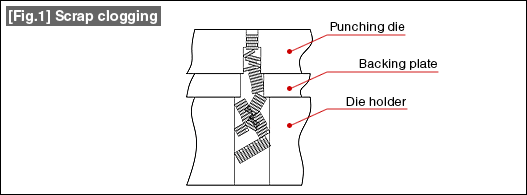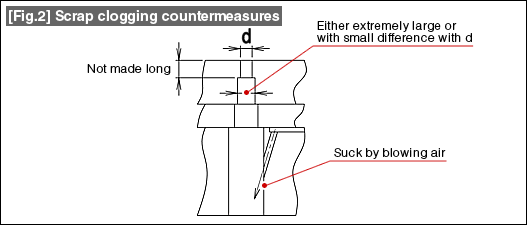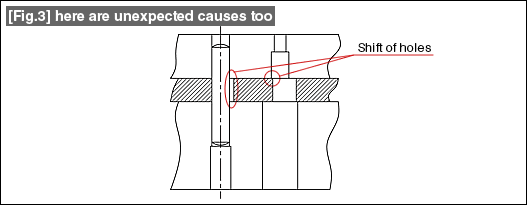#165 Problems in Punching and their Countermeasures (4) Scrap Clogging in Punching
In punching operations, scrap rising and scrap clogging can be said to be a double-sided problem. While dent marks on the product caused by scrap rising is a problem, the problem of punching scrap getting clogged in the die will be as shown in Fig. 1.

Normally, it is likely considered that each punching scrap passes through the die and falls down individually. However, many scrap pieces stick together in the form of a rod due to burrs or the oil used during punching and fall down as rods with some lengths. At this time, depending on the size of the holes through which the scrap falls, the joined scraps may fall inclined in the hole and get struck or stopped inside the hole thereby causing piling up and clogging of the scraps that fall thereafter. In the worst case, this can break the die. Since this cannot be seen from outside, very often one comes to know about the scrap clogging only after the die has broken.
Most often the cause of scrap clogging is due to continuing to punch in a state that is not normal and to use the die even after it has worn and the burrs have become large thereby leading to scrap clogging. While such use cannot be permitted, let us consider the causes and countermeasures. See Fig. 2.

There are some people who think that by making the cutting edge portion of the punching die long it is possible to use the die for a long time even if regrinding is done during maintenance. In such dies, there is the phenomenon of scrap getting fused to the side wall of the die because the scrap rubs against the side wall of the die when it is passing through the die, which results in scrap clogging. It is better that the length of this part is short with a length enough for about 2 or 3 pieces of scrap to get collected.
Relative to the die hole diameter (d), it is said that scrap clogging can occur easily when the diameter of the escape hole below it is about two times d. The countermeasure is to make the diameter of that hole have a small difference with d. Good effect is obtained by making the cross-section of the hole tapered or stepped. On the extreme side, there is also the method of making the hole very large for the scrap to pass through.
It goes without saying that it is better when the side wall of the hole for the scrap to pass through is smooth rather than rough.
There is also the method of sucking out scrap. We frequently see people using a vacuum cleaner for this purpose. There is also the method in which an inclined hole is drilled in the hole for letting scrap pass through and the scrap is sucked out by blowing air through this inclined side hole. This method is also effective against scrap rising. The trick is to make the inclined hole as upright as possible and to make its diameter small. This is because the sucking force increases when the speed of flow of air is increased and not due to the pressure of air.
There are also some unexpected causes. Such an example is shown in Fig. 3.

When a dowel pin (knock pin) is inserted in a part constituted by a die plate, a backing plate, and a die holder as shown in this figure, the hole of the backing plate is often drilled with a slightly larger diameter. When this drill hole gets shifted with respect to the dowel pin, scrap clogging occurs if the scrap passing hole of the punched part becomes as shown in the figure. If this is the cause, it is quite difficult to detect hence taking a long time to implement the correct countermeasures. Care should be taken about such problems.
- #167 Problems in Punching and their Countermeasures (6) Scrap Processing in Punching
- #166 Problems in Punching and their Countermeasures (5) Trimming of Drawn and Shaped Parts
- #165 Problems in Punching and their Countermeasures (4) Scrap Clogging in Punching
- #164 Problems in Punching and their Countermeasures (3) Bending and Twisting of Narrow Punched Parts
- #163 Problems in Punching and their Countermeasures (2) Bending due to Punching



